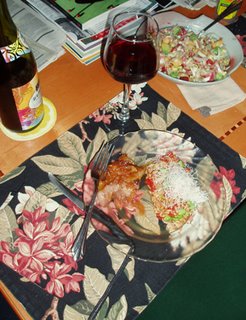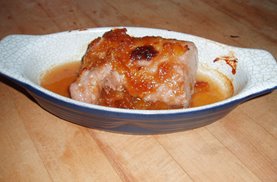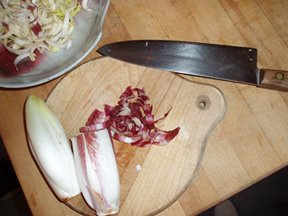 The Salted Pork Loin
The Salted Pork LoinHerewith my report on the pre-salting experiment, as outlined in the previous post.
I started with good, organically raised, lean pork. As I described in yesterday's blog entry, it was salted for a little over 24 hours. Except for the pre-salting, I followed my usual methods of cooking covered, 20 minutes in a moderate (350 degree) oven, followed by uncovered, under a broiler for 5 minutes more.
The result: An almost veal-like texture. T's comment: the meat seems "perfectly cooked." Fully cooked, with just a hint of pinkness at the center, without a trace of the dryness that suggests overcookeding. His take on the texture -- firm and moist at the same time. Mine: Lots of juice, with the character of pork meat quite deliciously distinct, even with the absence of fat in the lean cut.
I shouldn't have been surprised that the meat seemed salty, since I use salt quite sparingly in my everyday kitchen. T tasted the meat first and immediately remarked on the saltiness, but said that although he didn't find it excessively so. Indeed judging by how quickly he devoured it, it didn't bother him at all. For me, it was borderline, but I could probably adjust my taste with more experience of food cooked with this method. I'm very curious, now, to have a Zuni Cafe experience. I definitely want to try the method with chicken.
 What went right:
What went right:The chutney glaze was a good choice because it countered the saltiness with tangy sweetness. Many sauces, teriyaki or a mustard- or vinegar-based sauce for example, would have accented the saltiness, to the detriment of the meat.
What I'd do differently:
Next time I think I would try washing the salt off before glazing the meat. I suspect the difference would be subtle; the salt flavor was pervasive deep into the meat, but it might take the edge off it.
The focal point of the meal was the fine-textured, salty meat with its distinctive flavor and contrasting fruity glaze. The supporting players were a spelt pilaf with roasted red pepper and edamame, endive salad and a fresh red wine.
Spelt is an interesting grain with a nutmeat-like texture. It's cooked by searing in hot oil and then adding broth bit by bit until the grains are dry and toothsome. Tonight I used Trader Joe's Spelt with Red & Green Bell Peppers, but plain would do, too, in fact I'd prefer it, but I'm a pragmatic cook and that half-package was in my cupboard, waiting to be consumed.
Spelt is a bit tricky to get right, but I've learned a few things. These grains never seem to need as much liquid as the package recommends. To get a good texture, use a little less than half as much water as recommended. Olive oil was used for the saute step. Be careful not to let the oil overheat and produce smoke (and trans fats). After the grains are initially coated with oil, reduce the heat and toss and stir with a wooden spoon or spatula. Add water or broth slowly, allowing the grains to absorb the liquid before adding more, until you get the texture you want. This is basically the method given on the package.
On top of the dried flakes of peppers and seasonings that came in the Trader Joe's mix, I added my own diced red onions and freshly fire-roasted, seeded and peeled red peppers cut into small strips. As a finishing touch, when the spelt neared its state of perfection, I threw in a half-cup of pre-cooked edamame. The grains were served garnished with angel-hair parmesan. A new twist on the rice-and-beans side dish.
 For the salad, I started with Belgian endive, a favorite because of its crisp texture and slightly bitter flavor. Both red and green-leafed varieties were used. To this I added: diced red onion, chopped Haas avocado in perfect, buttery firm texture, a whole nectarine chopped into small pieces, and a half-cup of chopped walnut pieces, tossed with Champagne Pear Vinaigrette with gorgonzola cheese (another Trader Joe's find -- it's surprisingly low in calories!). Normally, I make this salad with apple, but I have these wonderful, full-sugar but still hard and crisp nectarines. That turned out to be a very good choice for this salad.
For the salad, I started with Belgian endive, a favorite because of its crisp texture and slightly bitter flavor. Both red and green-leafed varieties were used. To this I added: diced red onion, chopped Haas avocado in perfect, buttery firm texture, a whole nectarine chopped into small pieces, and a half-cup of chopped walnut pieces, tossed with Champagne Pear Vinaigrette with gorgonzola cheese (another Trader Joe's find -- it's surprisingly low in calories!). Normally, I make this salad with apple, but I have these wonderful, full-sugar but still hard and crisp nectarines. That turned out to be a very good choice for this salad.T had brought a 2005 George Duboeuf Beaujolais Nouveau and put it into the refrigerator for a light chill. Theoretically, its forward fruit would be a good match for the salty, buttery textured pork. This one didn't live up to that promise. T's speculation was that the 2005 may already have been too old. We would have preferred even bolder, fruitier flavors and less structure, but you can't score in every inning. As a dinner, it was above average. As a learning experience, it fulfilled all my expectations. It was fun.
Nutritional details
Spelt pilaf
1-1/4 cups water
1 tsp chicken base
1 red pepper
1 tbsp chopped red onion
3/4 c spelt
1/2 cup raw or frozen edamame
11/2 tbsp olive oil
1 tbsp parmesan cheese
Servings = 3
Serving size = 91 g
Calories = 231
Fat = 9.5 g
Carbs = 28 g
Protein = 3.3 g
Sodium = 444 mg
Cholesterol = 5.5 mg
Fiber = 22 g
Endive salad
2 whole Belgian endives, chopped
1 tbsp chopped red onion
1 small apple, pear or other firm-fleshed fruit, cut into small pieces
1/2 avocado cut into small pieces
1/4 cup chopped walnuts
2 tbsp Champagne Pear Vinaigrette dressing with Gorgonzola cheese
Servings = 4
Serving size = 136 g
Calories = 134
Fat = 9.6 g
Carbs = 11 g
Protein = 3.3 g
Sodium = 237 mg
Fiber = 12 g
Pre-salted pork loin with chutney glaze
Lean pork loin
Salt
2 tbsp Crosse & Blackwell Major Grey's Chutney
Servings = 2
Serving size = 131 g
Calories = 190
Fat = 4 g
Carbs = 14 g
Protein = 24 g
Sodium = 1225 mg
Cholesterol - 75 mg


0 Comments:
Post a Comment
<< Home